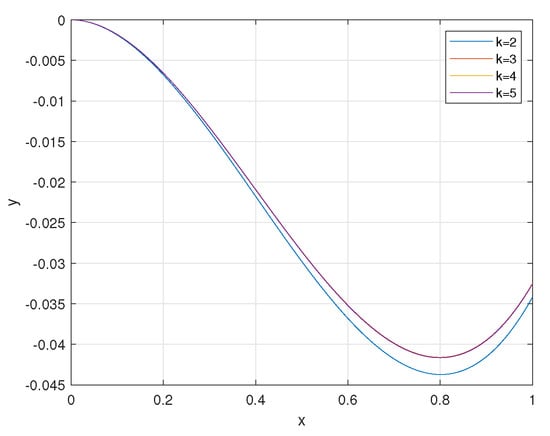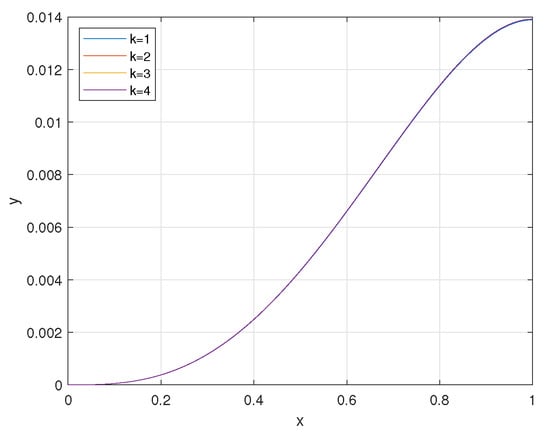Abstract
Fractional differential beam type equations are considered. By using an efficient approach, we prove the existence and uniqueness of continuous solutions. An iterative scheme for approximating the solution is given. Some examples are presented.
MSC:
34B40; 34B15; 35B09; 35B40
1. Introduction
Deformations of an elastic beam can be modeled by equations of the form
depending on how the beam is supported at the boundary (for more details, see, e.g., [1]).
This kind of equation has been investigated by many authors (see, e.g., [2,3,4,5,6,7,8,9,10,11], and references therein).
For instance, in [2], Aftabizadeh considered the problem
where satisfying some appropriate conditions. By transforming problem (1) into a second-order boundary value problem, and applying known results, the author proved an existence results.
Minhós et al. [12] proved the existence of a solution for
where satisfying a Nagumo-type condition. The proof is based on the degree theory.
Dang and Ngo [13] studied the problem
where
They have proved that problem (2) admits a unique solution. Their method consists of reducing the problem to an operator equation, then proving the contraction of the operator.
Currently, many researchers from various fields have become interested in the topic of fractional calculus based on integrals and derivatives of fractional order. It has numerous applications in the widespread field of science and engineering (see, for instance [14,15,16,17,18] and references therein). Fractional calculus offers superior tools to cope with the time-dependent effects noticed compared to integer-order calculus, which forms the mathematical foundation of most mathematical systems. As a result, fractional calculus is crucial to model real-life problems and finding mathematical solutions is a great challenge. Since fractional differential equations are used to model real-life problems, many mathematical methods (numerical/analytical/exact) are being developed to obtain the solutions to fractional differential equations/models/systems.
Throughout this paper, we refer to , for the Riemann–Liouville fractional derivative (see Definition 2).
In [19], the authors studied the problem
where and .
Existence results of positive solutions are obtained for the above problem by means of lower and upper solution methods.
In [20], the author proved some existence results for
where and , which need not to be a Caratheodory function. An approximating of the solution is also obtained.
The approach relies on the Schäuder fixed-point theorem.
In [21], by using the Schäuder fixed point theorem, the authors proved the existence of a unique positive solution to the problem
where with and satisfying some appropriate conditions.
More related existence results can be found in [22,23,24,25,26,27,28] and their references.
In this paper, motivated by the previous cited works, we are interested in the study of the following fractional beam type problem:
where and satisfying some sufficient conditions.
Our goal is to address the existence and uniqueness of a solution for the above problem. The convergence of an iterative process to the unique solution is also proposed. The method consists at reducing the problem to an operator equation, then proving the contraction of the operator.
2. Preliminary Results
Definition 1
([15,16,17,18]). Let and be a measurable function. Then, is defined by
where Γ is the Euler Gamma function.
Definition 2
([15,16,17,18]). Let and its integer part. Let be a given function, then is defined by
where
Lemma 1
([15,16,17,18]). Let and . Then,
- (i)
- and where
- (ii)
- if and only ifwhere is the ceiling function and
- (iii)
- If thenwhere is the ceiling function and
Lemma 2
([28]). Let and The problem,
admits a unique solution
where
Remark 1.
Note that for all
For define on the space by
For we let
It is clear that
Lemma 3
Let and Then, for
3. Main Results
Let and For we let
and we denote by
Theorem 1.
Consider h in and assume that for some and we have
- (i)
- for any
- (ii)
- for any
- (iii)
Proof.
Assume that T has a fixed point Then, by ([18], Theorem 2.4), (4) and Lemma 2,
is a continuous solution of problem (3). Conversely, if is a continuous solution of problem (3), then satisfies
Thus, solving problem (3) is equivalent to finding a fixed point for the operator
We claim that T maps into itself. Note that
On the other hand, due to Lemma 3, we obtain
So, for and therefore by assumption (i).
Next, for we have
Since , we deduce that T is a contraction on
To study the positivity, we denote by
Corollary 1.
Consider h in and assume that for some and we have
- (i)
- for any
- (ii)
- for any
- (iii)
Theorem 2.
(Iterative method) Under the same hypotheses of Theorem 1, let ϑ be the unique solution of problem (3) and consider the following iterative process:
Then,
where
In particular,
Proof.
Let such that
It is known from the Banach contraction principle (see, for instance ([29], Theorem 1.1)) that the sequence converges to and we have
Therefore, by using Lemma 3, we deduce
Since we deduce that
□
Example 1.

For and consider
We have
On can easy verify that the assumptions in Theorem 1 hold, for example, with and
Hence, problem (7) admits a unique continuous solution ϑ satisfying
Take Then, graphs of the successive approximation of are presented in Figure 1.

Figure 1.
Approximation of the solution for Example 1.
Example 2.

We have By Applying Theorem 1 with we obtain the uniqueness of the zero solution. Take Some iterations of the sequence are depicted in Figure 2.

Figure 2.
Approximation of .
Example 3.

For consider
In this example,
Assumptions in Theorem 1 are valid with and Therefore, by Corollary 1 problem (9) admits a unique solution with
Approximation of the solution can be achieved by the sequence with Some iterations are depicted in Figure 3.

Figure 3.
Approximation of the solution regarding Example 3.
4. Conclusions
In this work, we presented a new approach to study a class of Riemann–Liouville fractional differential equations of beam type. Under suitable conditions, we have proved the existence and uniqueness of continuous solutions by reducing the problem to an operator equation, then proving the contraction of the operator. Some examples with numerical approximation are given. In future works, we can extend this problem to more fractional derivatives, such as the Hadamard fractional derivative, -Hilfer and Quantum Fractional Derivatives.
Author Contributions
Methodology, I.B., H.E. and S.M.; Investigation, I.B., H.E. and S.M. All authors have read and agreed to the published version of the manuscript.
Funding
This research is supported by Researchers Supporting Project number (RSPD2023R946), King Saud University, Riyadh, Saudi Arabia.
Institutional Review Board Statement
Not applicable.
Informed Consent Statement
Not applicable.
Data Availability Statement
Not applicable.
Conflicts of Interest
The authors declare no conflict of interest.
References
- Reiss, E.L.; Callegari, A.J.; Ahluwalia, D.S. Ordinary Differential Equations with Applications; Holt, Rinehart and Winston: New York, NY, USA, 1976. [Google Scholar]
- Aftabizadeh, A.R. Existence and uniqueness theorems for fourth-order boundary value problems. J. Math. Anal. Appl. 1986, 116, 415–426. [Google Scholar] [CrossRef]
- Bai, Z. The upper and lower solution method for some fourth-order boundary value problems. Nonlinear Anal. 2007, 67, 1704–1709. [Google Scholar] [CrossRef]
- Dang, Q.A. Iterative method for solving the Neumann boundary value problem for biharmonic type equation. J. Comput. Appl. Math. 2006, 196, 634–643. [Google Scholar] [CrossRef]
- Dang, Q.A.; Dang, Q.L.; Ngo, T.K.Q. A novel efficient method for nonlinear boundary value problems. Numer. Algor. 2017, 76, 427–439. [Google Scholar]
- Gupta, C.P. Existence and uniqueness theorems for the bending of an elastic beam equation. Appl. Anal. 1988, 264, 289–304. [Google Scholar] [CrossRef]
- Gupta, C.P. Existence and uniqueness theorems for a fourth order boundary value problem of Sturm-Liouville type. Differ. Integral Equ. 1991, 4, 397–410. [Google Scholar] [CrossRef]
- Li, Y. A monotone iterative technique for solving the bending elastic beam equations. Appl. Math. Comput. 2010, 217, 2200–2208. [Google Scholar] [CrossRef]
- Li, Y. Existence of positive solutions for the cantilever beam equations with fully nonlinear terms. Nonlinear Anal. 2016, 27, 221–237. [Google Scholar] [CrossRef]
- Li, Y.; Liang, Q. Existence results for a fully fourth-order boundary value problem. J. Funct. Spaces Appl. 2013, 2013, 641617. [Google Scholar] [CrossRef]
- Wei, Y.; Song, Q.; Bai, Z. Existence and iterative method for some fourth order nonlinear boundary value problems. Appl. Math. Lett. 2019, 87, 101–107. [Google Scholar] [CrossRef]
- Minhós, F.; Gyulov, T.; Santos, A.I. Lower and upper solutions for a fully nonlinear beam equation. Nonlinear Anal. 2009, 71, 281–292. [Google Scholar] [CrossRef]
- Dang, Q.A.; Ngo, T.K.Q. Existence results and iterative method for solving the cantilever beam equation with fully nonlinear term. Nonlinear Anal. Real World Appl. 2017, 36, 56–68. [Google Scholar] [CrossRef]
- Hilfer, R. Applications of Fractional Calculus in Physics; World Scientific: Singapore, 2000. [Google Scholar]
- Kilbas, A.; Srivastava, H.; Trujillo, J. Theory and Applications of Fractional Differential Equations. In North-Holland Mathematics Studies; Elsevier: Amsterdam, The Netherlands, 2006; Volume 204. [Google Scholar]
- Miller, K.; Ross, B. An Introduction to the Fractional Calculus and Fractional Differential Equations; Wiley: New York, NY, USA, 1993. [Google Scholar]
- Podlubny, I. Fractional Differential Equations; Academic Press: New York, NY, USA, 1999. [Google Scholar]
- Samko, S.; Kilbas, A.; Marichev, O. Fractional Integrals and Derivative. Theory and Applications; Gordon and Breach: Yverdon, Switzerland, 1993. [Google Scholar]
- Liang, S.; Zhang, J. Positive solutions for boundary value problems of nonlinear fractional differential equation. Nonlinear Anal. 2009, 71, 5545–5550. [Google Scholar] [CrossRef]
- Liu, Y. Existence and non-existence of positive solutions of BVPs for fractional order elastic beam equations with a non-Caratheodory nonlinearity. Appl. Math. Model. 2014, 38, 620–640. [Google Scholar] [CrossRef]
- Mâagli, H.; Dhifli, A. Existence and asymptotic behavior of positive solutions for semilinear fractional Navier boundary-value problems. Electron. J. Differ. Equ. 2017, 141, 1–13. [Google Scholar]
- Agarwal, R.P.; O’Regan, D.; Staněk, S. Positive solutions for Dirichlet problems of singular nonlinear fractional differential equations. J. Math. Anal. Appl. 2010, 371, 57–68. [Google Scholar] [CrossRef]
- Bachar, I.; Mâagli, H.; Eltayeb, H. Existence and Iterative Method for Some Riemann Fractional Nonlinear Boundary Value Problems. Mathematics 2019, 7, 961. [Google Scholar] [CrossRef]
- Bai, Z.; Lü, H. Positive solutions for boundary value problem of nonlinear fractional differential equation. J. Math. Anal. Appl. 2005, 311, 495–505. [Google Scholar] [CrossRef]
- Graef, J.R.; Kong, L.; Kong, Q.; Wang, M. Existence and uniqueness of solutions for a fractional boundary value problem with Dirichlet boundary condition. Electron. J. Qual. Theory Differ. Equ. 2013, 55, 1–11. [Google Scholar] [CrossRef]
- Jassim, H.K.; Hussein, M.A. A New Approach for Solving Nonlinear Fractional Ordinary Differential Equations. Mathematics 2023, 11, 1565. [Google Scholar] [CrossRef]
- Sina, E.; Azhar, H.; Atika, I.; Jehad, A.; Shahram, R.; George Maria, S.A. On a fractional cantilever beam model in the q-difference inclusion settings via special multi-valued operators. J. Inequal. Appl. 2021, 174, 20. [Google Scholar]
- Zhang, X.; Liu, L.; Wu, Y. Multiple positive solutions of a singular fractional differential equation with negatively perturbed term. Math. Comput. Model. 2012, 55, 1263–1274. [Google Scholar] [CrossRef]
- Agarwal, R.P.; Jleli, M.; Samet, B. Fixed Point Theory in Metric Spaces. Recent Advances and Applications; Springer: Singapore, 2018. [Google Scholar]
Disclaimer/Publisher’s Note: The statements, opinions and data contained in all publications are solely those of the individual author(s) and contributor(s) and not of MDPI and/or the editor(s). MDPI and/or the editor(s) disclaim responsibility for any injury to people or property resulting from any ideas, methods, instructions or products referred to in the content. |
© 2023 by the authors. Licensee MDPI, Basel, Switzerland. This article is an open access article distributed under the terms and conditions of the Creative Commons Attribution (CC BY) license (https://creativecommons.org/licenses/by/4.0/).